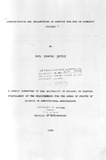| dc.contributor.author | Rotich, Paul K | |
| dc.date.accessioned | 2013-05-10T15:10:54Z | |
| dc.date.available | 2013-05-10T15:10:54Z | |
| dc.date.issued | 1998 | |
| dc.identifier.citation | Master of Science in Agricultural Engineering | en |
| dc.identifier.uri | http://erepository.uonbi.ac.ke:8080/xmlui/handle/123456789/21571 | |
| dc.description.abstract | Sawdust represents a considerable amount of energy that
is currently under-utilized. With an appropriate
thermodynamic process this by-product can be converted into
charcoal briquettes suitable for domestic use. In this study
sawdust was carbonized in a traditional brick-lined metal
kiln. Pyrolysis conditions were studied with particular
reference to temperature, air flow rate and moisture content.
Charcoal yields of 28% (dry weight basis) was obtained
from this system at pyrolysis temperatures of 450-550·C.
Lower yields were obtained at temperatures below and above
this range. Sawdust and wood containing moisture content of
40% and 35% respectively gave charcoal yields of 19.8%
compared wi th 28% for input wi th moi sture content of 30%
(sawdust) and 26% (fuelwood) on dry weight basis.
The energy content of sawdust, wood and their carbonized
products was determined using an adiabatic bomb calorimeter.
Fully carbonized charcoal had calorific value between 28MJ/kg
and 30 MJ/kg against 19 MJ/kg for uncarbonized sawdust.
Partially carbonized or torrid sawdust had calorific value of
23-24 MJ/kg. Proximate analysis revealed that the percentage
fixed carbon of pyrolysis products increases with the degree
of carbonization. The fixed carbon content was 56% and 70%
for fully carbonized sawdust charcoal and wood charcoal
respectively. Torrefied sawdust contained more volatiles but
less fixed carbon (50%).
Densification of sawdust charcoal was done using a hand operated
hydraulic press and mechanical briquetter. The bulk
density of briquettes could be increased from 160kg/rrf of
loose material to about 540 kg/rrf using a compression pressure
of 875N/cm2 in conjunction with either 5% molasses or 3%
starch 'binder. With a constant compression pressure of
350N/crrf the bulk density increased from 330 kg/rrfto 450kg/rrf
on increasing the ratio of molasses from 0 to 20%,
respectively. Fully carbonized sawdust charcoal was more
friable and had better briquetting properties than torrefied
sawdust.
Charcoal briquettes and ordinary lump charcoal were
burned in ordinary cookers and their combustion
characteristics compared. Charcoal briquettes caught fire
more ready than ordinary charcoal when lighting and on
average took 9 and 11 minutes respectively. Charcoal
briquettes reached' their peak glowing combustion 30 minutes
after ignition but their fire died out within one and a half
hours compared with 40 minutes and two hours respectively for
ordinary charcoal. | en |
| dc.language.iso | en | en |
| dc.publisher | University of Nairobi | en |
| dc.title | Carbonization and briquetting of sawdust for use in domestic cookers | en |
| dc.type | Thesis | en |
| local.publisher | Faculty of Agricultural Engineering | en |

